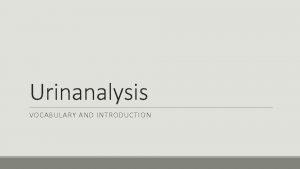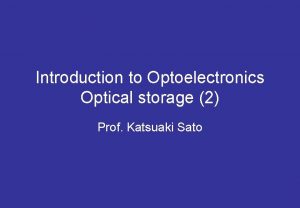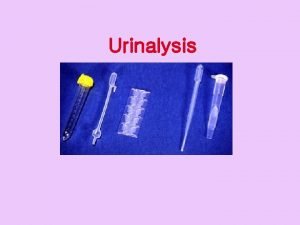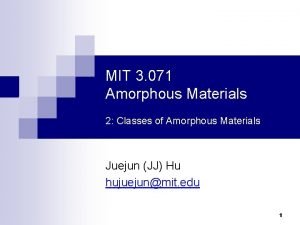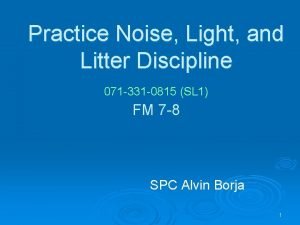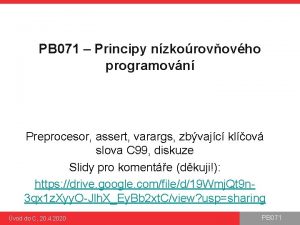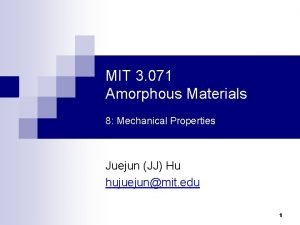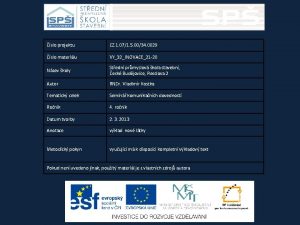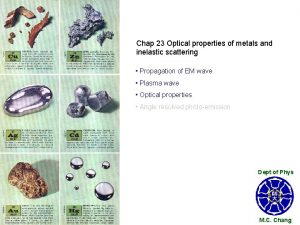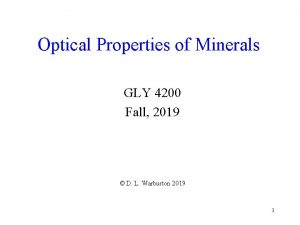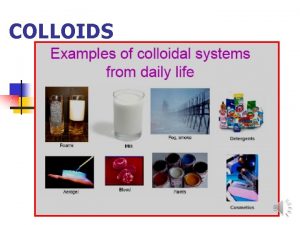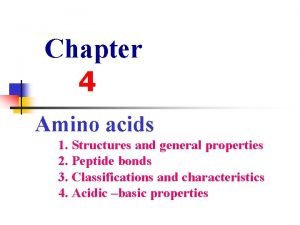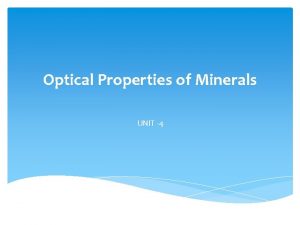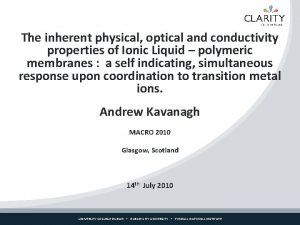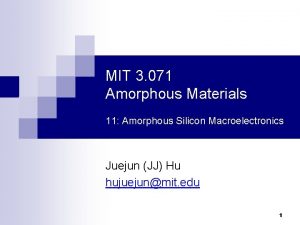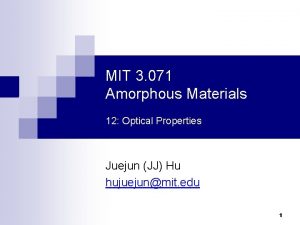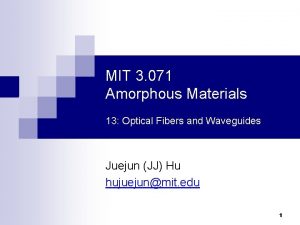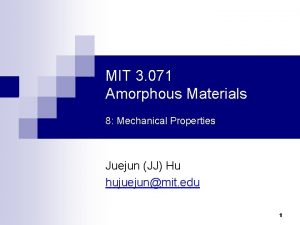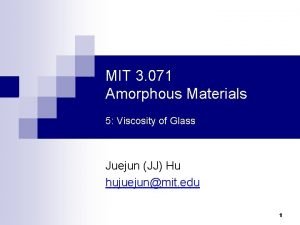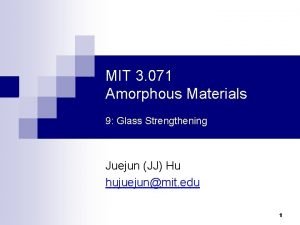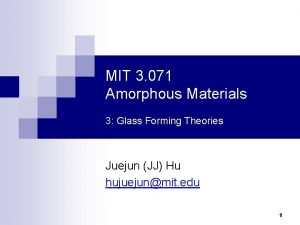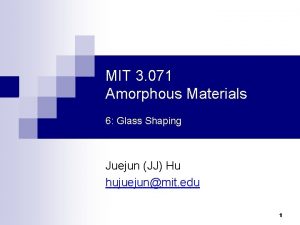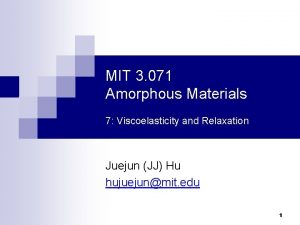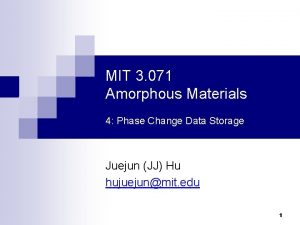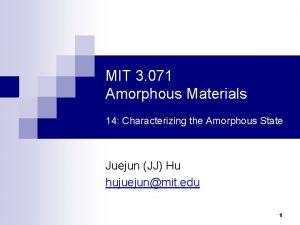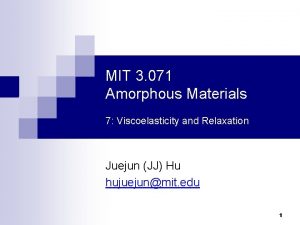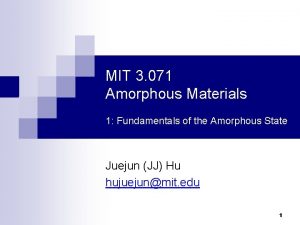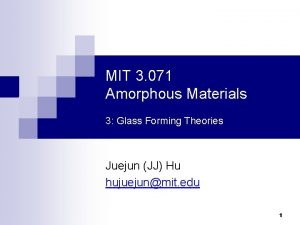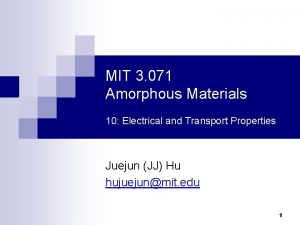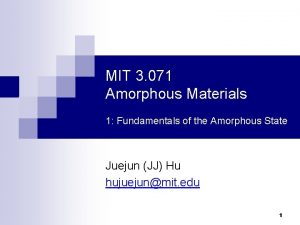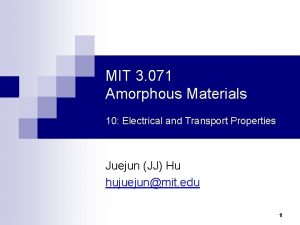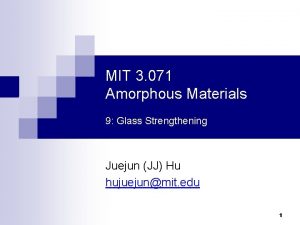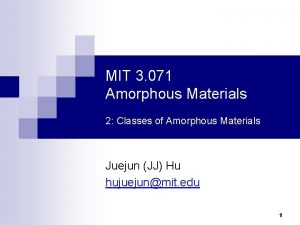MIT 3 071 Amorphous Materials 12 Optical Properties







































- Slides: 39

MIT 3. 071 Amorphous Materials 12: Optical Properties Juejun (JJ) Hu hujuejun@mit. edu 1

After-class reading list n Fundamentals of Inorganic Glasses ¨ n Introduction to Glass Science and Technology ¨ n Ch. 19 Ch. 10 3. 024 wave optics 2

What's so special about ? 3

Refraction Leeuwenhoek Microscope

Transparency Global submarine optical fiber networks 5

Color Palau de la Musica Catalana, Barcelona 6

Maxwell Equations (‘macroscopic’ differential form) n Gauss’s Law: n Gauss’s Law for magnetism: n Faraday’s Law: n Ampere’s Law: James C. Maxwell (1831 -1879) H Magnetic field B Magnetic induction E Electric field D Electric displacement Jf Free current density rf Free charge density 7

Constitutive relations in amorphous materials n General form for non-bianisotropic media: n Most amorphous materials are isotropic ¨ E and D (or B and H) always align in the same direction ¨ In most non-magnetic glasses, mr is close to 1 (m = m 0) Linear media Non-magnetic media 8

Refractive index of glass: general trends n Addition of heavy elements increases index ¨ n Addition of alkali oxides increases index ¨ n Lead-containing glasses NBOs have larger polarizability than BOs Fictive temperature (density) dependence Rawson, Properties and Applications of Glasses (1980) 9

Kramers-Kronig (K-K) relation a (w ) nr (w) -1 Refractive index n and optical absorption a are not independent quantities! w / w 0 10

Refractive index of glasses Wavelength/frequency dependent (Lorentz oscillators) n a Atomic/ionic absorption Electronic absorption n Atomic/ionic polarizability Electronic polarizability 1 X-ray UV Visible IR Static l 11

Chromatic dispersion of glasses Abbe number (V-number): n ¨ D, F and C spectral lines: 589. 3 nm, 486. 1 nm and 656. 3 nm F n D C Normal dispersion Anormalous dispersion 1 X-ray UV Visible IR Static l 12

Chromatic dispersion of glasses Prism dispersive spectrometer Chromatic aberration 13

Chromatic dispersion of glasses n Abbe number (V-number): Crown glass (“K”) n Soda-lime silicates n Low index n Low dispersion Flint glass (“F”) ers lym o al p n Lead glasses n High index n High dispersion tic Op 14

15

Dispersive concentrators for lateral solar spectrum splitting Dispersive lens Concentrating optics Combining two materials (glass & polymer) with identical refractive index and different dispersion to split sunlight without bending optical axis Lateral cell arrays

Dispersive concentrators: outdoor testing Simulation Experiment

Optical loss in silica glass The Nobel Prize in Physics 2009 Charles Kuen Kao Prize motivation: "for groundbreaking achievements concerning the transmission of light in fibers for optical communication" 18

Optical loss / attenuation mechanisms Semiconductor optoelectronics Soda-lime glass in the infrared Transparent ceramics Fiber-optic glasses Electronic absorption Phonon absorption Defect scattering Rayleigh scattering Absorption induced by electronic transitions Absorption resulting from atomic / ionic vibrations Scattering by Scattering due to crystalline grains, density, structure grain boundaries, or composition micro-voids, etc. fluctuations 19

Optical loss mechanisms in glasses n Extrinsic absorption (impurities or dopants) ¨ Transition metal or rare earth ions Vibrational absorption Intrinsic attenuation ¨ Band-to-band transitions ¨ Urbach tail absorption ¨ Mid-gap defect state absorption ¨ Free carrier absorption (FCA) ¨ n Phonon (vibrational) absorption ¨ Rayleigh scattering • Density fluctuation • Structural moieties ¨ Color codes: Atomic/ionic absorption Electronic absorption Scattering 20

Electronic absorption in amorphous solids E 4 1 Conduction band 3 1. Band-to-band transition 2. Urbach bandtail absorption 3. Defect state absorption Urbach tail 4. Free carrier absorption Mid-gap states 2 Mobility edge Valence band DOS 21

Electronic absorption in amorphous solids 4 E 1. Band-to-band transition 1 3 ET : Tauc gap 2 Band-toband transition DOS ET = 2. 1 e. V A. Stern, Photodiodes – World Activities in, 267 (2011). 22

Electronic absorption in amorphous solids 4 E 1. Band-to-band transition 1 2. Urbach bandtail absorption 3 2 DOS Urbach tail absorption A. Stern, Photodiodes – World Activities in, 267 (2011). 23

Electronic absorption in amorphous solids 4 E 1. Band-to-band transition 1 2. Urbach bandtail absorption 3 2 DOS A: band-to-band B: Urbach tail C: Dangling bonds L. Ley, The Physics of Hydrogenated Amorphous Silicon, 141 (1984). 24

Electronic absorption in amorphous solids 4 E 1. Band-to-band transition 1 2. Urbach bandtail absorption 3 3. Defect state absorption 2 DOS A: band-to-band B: Urbach tail C: Dangling bonds L. Ley, The Physics of Hydrogenated Amorphous Silicon, 141 (1984). 25

Electronic absorption in amorphous solids 4 E 1. Band-to-band transition 1 2. Urbach bandtail absorption 3 3. Defect state absorption 4. Free carrier absorption 2 Absorption coefficient (cm-1) DOS § Band-to-band: > 103 § Bandtail and defect states: 1 – 103 § FCA: generally weak in amorphous solids 26

Vibrational absorption Atom k Harmonic oscillator m m Bond Energy Atomic spacing Compound or Primary functional absorption group bands (mm) O-H 2. 92 S-H 4. 01, 3. 65, 3. 11, 2. 05 Ge-H 4. 95 P-H 4. 35 As-H 5. 02 Si-O 9. 1 – 9. 6 Ge-O 12. 8 H 2 O 6. 3, 2. 8 J. Optoelectron. Adv. Mater. 3, 341 (2001) 27

Infrared windows of common optical materials Black diamond (BD-2): Ge 28 Sb 12 Se 60 Cleartran. TM: Zn. Se 28

Sources of Rayleigh scattering in glass n n Local density fluctuation ¨ p : photoelastic constant ¨ b : isothermal compressibility Concentration scattering ¨ Local composition fluctuation in multi-component glasses Ann. Physik 33, 1275 (1910); Ann. Physik 25, 205 (1908); J. Appl. Phys. 55, 4052 (1984). Einstein-Smoluchowski scattering: density fluctuation of atmosphere 29

Intrinsic optical loss spectrum in glass log(a) Rayleigh scattering limited Phonon absorption limited Minimum loss window log(l) Total loss: 30

Total optical loss in glasses Si. O 2 Electron. Lett. 17, 775 (1981). Si. O 2 Ca. F 2 -Ba. F 2 YF 3 -Al. F 4 Concentration scattering is not taken into account, resulting in unrealistically low loss values Ge. S 3 Ba. F 2 -Gd. F 4 -Zr. F 4 31

Photo taken at the Corning Glass Science and Engineering Laboratory, Rutgers University, 03/31/2017 32

Transparent glass coloring: absorption n Transition metal or rare earth ion additives Green tint due to Fe 2+ ions Glass decolorization: 33

Examples of color glasses with ion additives Cobalt blue Chromium green Uranium glass (Vaseline glass) Room light UV illumination Manganese amethyst 34

Transparent glass coloring: scattering n Precipitation of small crystals or metal nanoparticles ¨ Rayleigh scattering by nanocrystals ¨ Plasmon resonance of metal nanoparticles Opalescent glass: nanocrystals Lycurgus Cup: Au-Ag nanoparticles 35

Striking colors n Coloring of glass via heat treatment n Example: gold-ruby striking Annealing at 500 – 700 °C O 2 Unfired Au+ Fired Au+ Melt at 1400 °C and quench Au nanoparticles (dia. 5 – 60 nm) Nature 407, 691 (2000) 36

Photochromic and electrochromic glasses n Optical or electrical control of redox state of ions n Carrier injection into transparent conductors to modulate FCA Bleached transparent Colored brown-gray Nature 500, 323 (2013) 37

Photochromic and electrochromic glasses n Optical or electrical control of redox state of ions n Carrier injection into transparent conductors to modulate FCA Nature 500, 323 (2013) 38

Summary n n n Refraction ¨ Microscopic origin of refraction and chromatic dispersion ¨ Composition dependence of refractive indices ¨ Abbe number Attenuation ¨ Optical loss mechanisms in general materials ¨ Optical loss mechanisms in glasses ¨ Electronic, vibrational, and scattering losses Coloring ¨ Ion additives ¨ Scattering by nanoparticles 39
 Optical properties of engineering materials
Optical properties of engineering materials Spermatozoa in urine
Spermatozoa in urine Honors its atomic
Honors its atomic Packing efficiency of hcp
Packing efficiency of hcp Crystalline solid and amorphous solid
Crystalline solid and amorphous solid Crystalline solids
Crystalline solids Crystalline solid and amorphous solid
Crystalline solid and amorphous solid Law of constancy of interfacial angle
Law of constancy of interfacial angle During the summit the factious ambassador caused
During the summit the factious ambassador caused Nocturia pronunciation
Nocturia pronunciation Amorphous disk mark
Amorphous disk mark Alkaptouria
Alkaptouria Amorphous
Amorphous Uric acid crystal
Uric acid crystal React to indirect fire while dismounted powerpoint
React to indirect fire while dismounted powerpoint Practice noise light and litter discipline cit
Practice noise light and litter discipline cit Pb 071
Pb 071 Terrain features army
Terrain features army 072 atm error
072 atm error Perform surveillance without electronic devices
Perform surveillance without electronic devices Foo2123
Foo2123 N 3^071
N 3^071 071-com-4407
071-com-4407 071-com-0029
071-com-0029 071-com-4407
071-com-4407 Bcd addition of 184 and 576
Bcd addition of 184 and 576 Optical properties of metals and nonmetals
Optical properties of metals and nonmetals Optical properties of minerals
Optical properties of minerals Discuss the optical and electrical properties of colloids
Discuss the optical and electrical properties of colloids Optical properties of amino acids
Optical properties of amino acids Prismatic cleavage
Prismatic cleavage Inherent optical properties
Inherent optical properties Natural materials
Natural materials Useful and harmful materials worksheets
Useful and harmful materials worksheets Natural man made
Natural man made What is adopting materials
What is adopting materials Direct materials budget with multiple materials
Direct materials budget with multiple materials Marginal percolation
Marginal percolation Natural science grade 6 mixtures
Natural science grade 6 mixtures Modern materials textiles
Modern materials textiles









